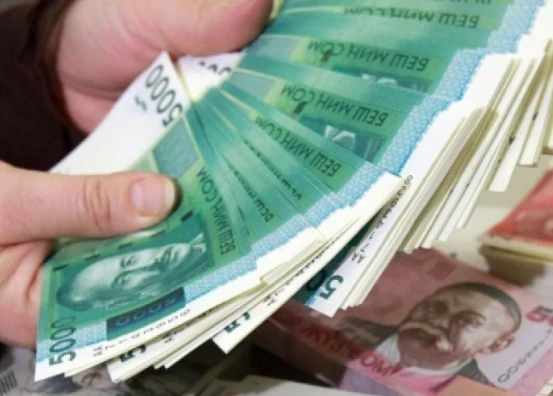
Kyrgyz folk percussion instruments form a small group. The arsenal of folk percussion instruments consists of three membranophones: dobulbash (in northern Kyrgyzstan — dobulbas), dool, and karsyldak. These instruments are carriers of rhythm, one of the strongest means of artistic influence on humans and animals.
In the musical practice of the 20th century, percussion instruments were almost not encountered and existed only as museum exhibits. However, in the 1980s, work began on the revival of the dobulbash and dool, which are currently represented in a minimal number of authorial copies.

Dobulbash — a single-sided frame drum covered with skin. The height of the body of a traditional dobulbash is 50—60 cm, and the diameter of the membrane is 25—30 cm. The first was made from juniper, and the second — from camel skin. The sound was produced by striking with the handle of a Kyrgyz whip (kamchy) or the palm. The modern method of sound production is with two sticks with soft tips. The sound of the dobulbash is strong, ringing, and prolonged (with a thick membrane), and can serve as a military or sacred signal.
The need for the revival of the dobulbash arose in the 1970s and 1980s in connection with the creation of folk instrumental ensembles.
The first modern samples of the dobulbash were made by masters from the Osh region. The republican press reported about them: “The ancient musical instrument of the Kyrgyz — the dobulbash drum has sounded. Once considered forever lost, it was mentioned only in folk legends... Having meticulously studied them, master T. Ergeshov made a copy of this instrument.” Ergeshov constructed the dobulbash in three varieties — large, medium, and small. They differ in size but are similar in shape.
In performance practice, other authorial variants of the dobulbash are also used. In the orchestra of the M. Abdrayev Republican Secondary Special Music School, three varieties of dobulbash of a jug-like shape are used. They were made in the experimental workshop of Kyrgyz folk instruments at the Kyrgyz State Philharmonic.
In 1987, master O. Kenchinbaev constructed new orchestral variants of the modernized dobulbash, which form a family of four varieties — bass, baritone, tenor, and alto. These instruments became part of the folk orchestra "Min kyial" of the "Ak-Maaral" dance ensemble and the musical-ethnographic ensemble "Kambarakan" of the Kyrgyz State Philharmonic.
The construction of these instruments consists of the following elements:
• a kettle (chara), made from a solid piece of wood (oak, walnut, spruce) by hollowing out and decorated with Kyrgyz national ornament;
• resonator holes (kozonok), located on the sides and the lower part of the body;
• membrane (teri) — skin stretched over the kettle with the help of a round hoop and secured with bolts. The turns of the bolt adjust the pitch of the instrument within the interval of a major second.
All four instruments stand on special stands.
The sizes of the mentioned types of dobulbash and their main tuning tones are as follows:
dobulbash-bass (A of the great octave) — kettle height 65 cm, membrane diameter 44 cm, body circumference 139 cm;
dobulbash-baritone (G of the small octave) — height 50 cm, diameter 30 cm, circumference 95 cm;
dobulbash-tenor (C of the first octave) — height 42 cm, diameter 25 cm, circumference 78 cm;
dobulbash-alto (F of the first octave) — height 35 cm, diameter 20 cm, circumference 63 cm.
Modernized dobulbash: alto, tenor, baritone, bass
Dool — a small wooden or metal membranophone. Currently, there are two types of it — traditional and reconstructed. The first is a helmet-shaped drum with a tightly stretched membrane. The diameter of the membrane, also made from animal skin (camel, bull), is about 30 cm, and the height of the body is about 20 cm. A strong and low sound was produced using a wooden stick (tokmok, or tayak), thickened at the end. Straps on both sides of the instrument allowed it to be attached to the saddle in front of the performing rider. The dool sounded on solemn occasions as well as during hunting.
Researchers of the past described the cult-functional role of the dool — the Kyrgyz "bubna" or "drum," which served as a tool for the bakshy-shaman to drive away evil spirits. In the epic "Manas," the signaling role of the dool is emphasized, particularly in the ensemble of percussion and wind instruments.

The modernized dool in the form of a kettle-drum was constructed by master O. Kenchinbaev and is successfully used in contemporary ensemble practice.

Karsyldak — a pair of wooden spoon-shaped open boxes, fastened together at the narrow ends. The maximum width of one piece is 10 cm, and the length is 20 cm.
“Tuned” differently due to their unequal sizes, they produce clicking sounds of varying pitch when struck lightly.
















































